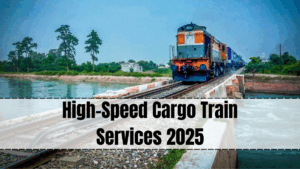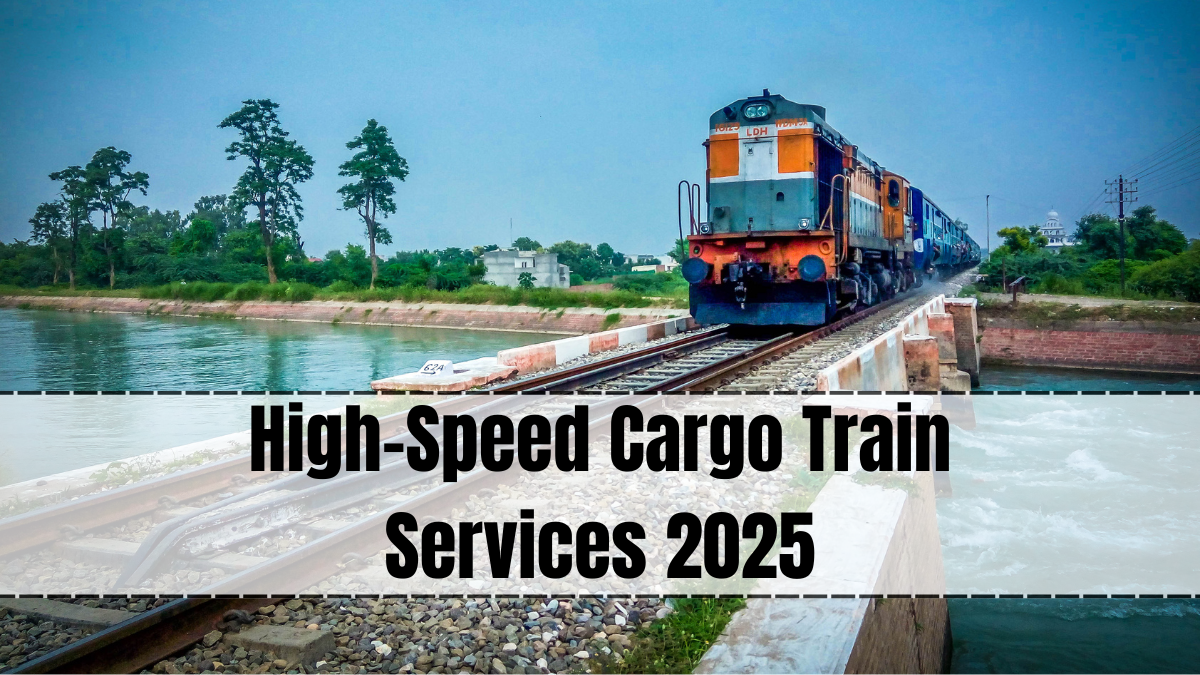India’s transportation and logistics sector is undergoing a major upgrade in 2025 with the launch of high-speed cargo train services. These specialized trains are designed to drastically reduce transit time for goods, improve supply chain efficiency, and strengthen economic connectivity between cities. By leveraging advanced rail technology, the government aims to make freight transport faster, more reliable, and environmentally friendly.
The introduction of freight train upgrades represents a strategic move to boost industrial growth while reducing dependence on road transport, which often faces delays due to traffic congestion and weather conditions.

Why High-Speed Cargo Trains Are a Game-Changer
Traditional freight trains operate at speeds between 60–75 km/h, making deliveries slower compared to modern logistics demands. In contrast, the new high-speed cargo trains can operate at speeds of 120–160 km/h, cutting delivery times by nearly half. This is especially beneficial for:
-
Perishable Goods – Faster transport keeps products fresh.
-
Industrial Shipments – Reduces downtime in manufacturing supply chains.
-
E-commerce Logistics – Enables quicker order fulfillment across states.
-
Agricultural Produce – Ensures farmers get better market prices due to faster delivery.
The speed advantage directly translates to increased competitiveness for Indian businesses.
Key Features of the 2025 High-Speed Cargo Train Services
The high-speed cargo train system comes with multiple technological upgrades:
-
Dedicated Freight Corridors – Separate tracks for cargo to avoid delays caused by passenger trains.
-
Automated Loading Systems – Reduces manual labor and loading time.
-
Refrigerated Coaches – For transporting perishable goods such as dairy, fruits, and seafood.
-
Real-Time Tracking – GPS-enabled wagons allow businesses to monitor shipments live.
-
Energy-Efficient Engines – Designed to reduce fuel consumption and carbon emissions.
These features collectively ensure that cargo transportation is faster, safer, and more sustainable.
Economic Benefits of High-Speed Freight
The launch of high-speed cargo trains will have far-reaching effects on India’s logistics economy:
-
Reduced Transit Costs – Lower fuel and labor expenses for businesses.
-
Boost to Export Competitiveness – Faster port-to-market connections.
-
Job Creation – In rail operations, maintenance, and logistics hubs.
-
Support for Small Businesses – Affordable freight options for smaller consignments.
This initiative is expected to significantly enhance India’s position in global trade rankings.
Environmental Impact
Shifting freight movement from trucks to railways reduces carbon emissions, road congestion, and highway wear-and-tear. The new high-speed system is powered by energy-efficient locomotives, with future plans to integrate electric and hybrid engines for even lower environmental impact.
Additionally, the use of dedicated freight corridors minimizes interference with passenger train schedules, leading to smoother operations across the railway network.
Challenges in Implementation
While the benefits are substantial, a few challenges need to be addressed:
-
Infrastructure Development – Laying new high-speed freight tracks requires time and investment.
-
Integration with Existing Systems – Coordinating with ports, warehouses, and trucking services.
-
Initial Costs for Businesses – While faster, the service may initially be priced higher.
-
Technology Training – Staff must be trained to operate and maintain new systems.
The government is actively partnering with private logistics companies to overcome these hurdles.
Future of High-Speed Cargo Trains in India
The success of the high-speed cargo train services in 2025 is expected to pave the way for:
-
Pan-India High-Speed Freight Network – Linking all major industrial hubs.
-
International Freight Links – Connecting with neighboring countries for cross-border trade.
-
AI-Driven Scheduling – Optimizing train routes and schedules to maximize efficiency.
-
Smart Logistics Hubs – Fully automated cargo handling centers at key junctions.
These developments will further strengthen India’s logistics ecosystem.
Final Thoughts
The High-Speed Cargo Train Services 2025 initiative is a landmark achievement for India’s railways and logistics sector. By combining speed, efficiency, and sustainability, it offers businesses a competitive edge and contributes to economic growth.
As more industries and supply chains adopt this mode of transport, India’s freight movement will become faster, greener, and better equipped to meet global standards.
FAQs
How fast will the new high-speed cargo trains run?
They can operate at speeds of 120–160 km/h, nearly double that of traditional freight trains.
Will these trains carry both goods and passengers?
No, they are dedicated to cargo only, ensuring faster and uninterrupted deliveries.
Are refrigerated wagons available for perishable goods?
Yes, the service includes temperature-controlled coaches for items like fruits, vegetables, and seafood.
How will businesses track their shipments?
A GPS-based real-time tracking system will allow live monitoring of goods in transit.
Is this service available across all of India in 2025?
Initially, it is being launched on priority industrial and agricultural corridors, with gradual expansion planned.
Click here to know more.
